Unit4说课稿
- 格式:doc
- 大小:20.62 KB
- 文档页数:6
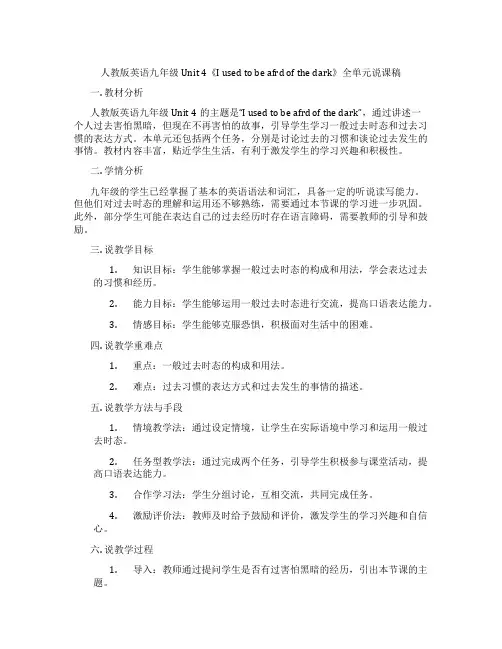
人教版英语九年级Unit 4《I used to be afrd of the dark》全单元说课稿一. 教材分析人教版英语九年级Unit 4的主题是“I used to be afrd of the dark”,通过讲述一个人过去害怕黑暗,但现在不再害怕的故事,引导学生学习一般过去时态和过去习惯的表达方式。
本单元还包括两个任务,分别是讨论过去的习惯和谈论过去发生的事情。
教材内容丰富,贴近学生生活,有利于激发学生的学习兴趣和积极性。
二. 学情分析九年级的学生已经掌握了基本的英语语法和词汇,具备一定的听说读写能力。
但他们对过去时态的理解和运用还不够熟练,需要通过本节课的学习进一步巩固。
此外,部分学生可能在表达自己的过去经历时存在语言障碍,需要教师的引导和鼓励。
三. 说教学目标1.知识目标:学生能够掌握一般过去时态的构成和用法,学会表达过去的习惯和经历。
2.能力目标:学生能够运用一般过去时态进行交流,提高口语表达能力。
3.情感目标:学生能够克服恐惧,积极面对生活中的困难。
四. 说教学重难点1.重点:一般过去时态的构成和用法。
2.难点:过去习惯的表达方式和过去发生的事情的描述。
五. 说教学方法与手段1.情境教学法:通过设定情境,让学生在实际语境中学习和运用一般过去时态。
2.任务型教学法:通过完成两个任务,引导学生积极参与课堂活动,提高口语表达能力。
3.合作学习法:学生分组讨论,互相交流,共同完成任务。
4.激励评价法:教师及时给予鼓励和评价,激发学生的学习兴趣和自信心。
六. 说教学过程1.导入:教师通过提问学生是否有过害怕黑暗的经历,引出本节课的主题。
2.新课呈现:教师通过讲解和示范,教授一般过去时态的构成和用法。
3.实践环节:学生分组讨论过去的习惯和经历,用一般过去时态进行交流。
4.任务一:学生分组完成第一个任务,讨论过去的习惯,并展示给其他小组。
5.任务二:学生分组完成第二个任务,谈论过去发生的事情,并展示给其他小组。

【人教版】三年级上英语《Unit 4 》第二课时优质公开课说课稿一. 教材分析《Unit 4》是人教版三年级上册英语教材的一个单元,本单元的主题是“My family and friends”。
第二课时主要围绕家庭成员和朋友的介绍展开,通过学习本课时,学生能够掌握家庭成员和朋友的基本词汇,如father, mother, sister, brother, friend等,以及能够用英语简单介绍自己的家庭成员和朋友。
二. 学情分析三年级的学生已经掌握了基本的英语发音和一些日常用语,对于本课时的话题,学生在生活中已经有了一定的认知,能够理解家庭成员和朋友的概念。
但是,学生的英语听说能力还有限,需要在课堂上通过大量的练习来提高。
三. 说教学目标1.知识目标:学生能够掌握家庭成员和朋友的基本词汇,如father,mother, sister, brother, friend等,并能够用英语简单介绍自己的家庭成员和朋友。
2.能力目标:学生能够听懂并能够用英语进行家庭成员和朋友的介绍。
3.情感目标:通过学习本课时,学生能够增强对家庭和朋友的情感认识,更加珍惜自己的家人和朋友。
四. 说教学重难点1.重点:家庭成员和朋友的基本词汇的掌握和运用。
2.难点:能够用英语进行家庭成员和朋友的介绍。
五. 说教学方法与手段在本课时的教学中,我将采用情境教学法、交际法和生活化教学法。
通过设置情境,让学生在真实的语境中学习和运用英语。
同时,我将运用多媒体教学手段,如图片、视频等,激发学生的学习兴趣,提高学生的学习积极性。
六. 说教学过程1.热身(5分钟):通过播放一首关于家庭成员和朋友的英文歌曲,让学生在轻松愉快的氛围中进入学习状态。
2.课堂导入(10分钟):通过展示一张全家福照片,引导学生谈论自己的家庭成员,为新课的学习做好铺垫。
3.新课呈现(15分钟):通过展示图片和视频,引导学生学习家庭成员和朋友的基本词汇,如father, mother, sister, brother, friend等,并进行听力练习。
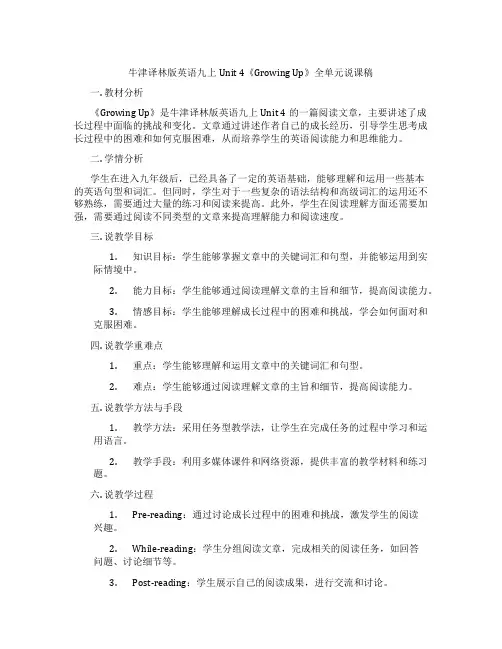
牛津译林版英语九上Unit 4《Growing Up》全单元说课稿一. 教材分析《Growing Up》是牛津译林版英语九上Unit 4的一篇阅读文章,主要讲述了成长过程中面临的挑战和变化。
文章通过讲述作者自己的成长经历,引导学生思考成长过程中的困难和如何克服困难,从而培养学生的英语阅读能力和思维能力。
二. 学情分析学生在进入九年级后,已经具备了一定的英语基础,能够理解和运用一些基本的英语句型和词汇。
但同时,学生对于一些复杂的语法结构和高级词汇的运用还不够熟练,需要通过大量的练习和阅读来提高。
此外,学生在阅读理解方面还需要加强,需要通过阅读不同类型的文章来提高理解能力和阅读速度。
三. 说教学目标1.知识目标:学生能够掌握文章中的关键词汇和句型,并能够运用到实际情境中。
2.能力目标:学生能够通过阅读理解文章的主旨和细节,提高阅读能力。
3.情感目标:学生能够理解成长过程中的困难和挑战,学会如何面对和克服困难。
四. 说教学重难点1.重点:学生能够理解和运用文章中的关键词汇和句型。
2.难点:学生能够通过阅读理解文章的主旨和细节,提高阅读能力。
五. 说教学方法与手段1.教学方法:采用任务型教学法,让学生在完成任务的过程中学习和运用语言。
2.教学手段:利用多媒体课件和网络资源,提供丰富的教学材料和练习题。
六. 说教学过程1.Pre-reading:通过讨论成长过程中的困难和挑战,激发学生的阅读兴趣。
2.While-reading:学生分组阅读文章,完成相关的阅读任务,如回答问题、讨论细节等。
3.Post-reading:学生展示自己的阅读成果,进行交流和讨论。
七. 说板书设计板书设计主要包括文章的标题、关键词汇和主要句型,以便学生能够清晰地理解和记忆文章的内容。
八. 说教学评价教学评价主要通过学生的阅读理解测试和课堂参与度来进行。
对于阅读理解测试,可以设置一些选择题和问答题,以检查学生对文章主旨和细节的理解程度。
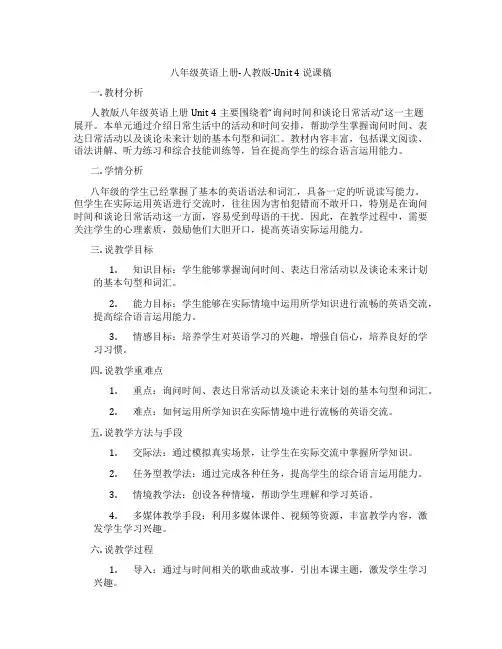
八年级英语上册-人教版-Unit 4 说课稿一. 教材分析人教版八年级英语上册Unit 4主要围绕着“询问时间和谈论日常活动”这一主题展开。
本单元通过介绍日常生活中的活动和时间安排,帮助学生掌握询问时间、表达日常活动以及谈论未来计划的基本句型和词汇。
教材内容丰富,包括课文阅读、语法讲解、听力练习和综合技能训练等,旨在提高学生的综合语言运用能力。
二. 学情分析八年级的学生已经掌握了基本的英语语法和词汇,具备一定的听说读写能力。
但学生在实际运用英语进行交流时,往往因为害怕犯错而不敢开口,特别是在询问时间和谈论日常活动这一方面,容易受到母语的干扰。
因此,在教学过程中,需要关注学生的心理素质,鼓励他们大胆开口,提高英语实际运用能力。
三. 说教学目标1.知识目标:学生能够掌握询问时间、表达日常活动以及谈论未来计划的基本句型和词汇。
2.能力目标:学生能够在实际情境中运用所学知识进行流畅的英语交流,提高综合语言运用能力。
3.情感目标:培养学生对英语学习的兴趣,增强自信心,培养良好的学习习惯。
四. 说教学重难点1.重点:询问时间、表达日常活动以及谈论未来计划的基本句型和词汇。
2.难点:如何运用所学知识在实际情境中进行流畅的英语交流。
五. 说教学方法与手段1.交际法:通过模拟真实场景,让学生在实际交流中掌握所学知识。
2.任务型教学法:通过完成各种任务,提高学生的综合语言运用能力。
3.情境教学法:创设各种情境,帮助学生理解和学习英语。
4.多媒体教学手段:利用多媒体课件、视频等资源,丰富教学内容,激发学生学习兴趣。
六. 说教学过程1.导入:通过与时间相关的歌曲或故事,引出本课主题,激发学生学习兴趣。
2.新课呈现:介绍本课的基本句型和词汇,通过图片、实物等辅助手段,帮助学生理解和记忆。
3.实践环节:模拟真实场景,让学生在实际交流中运用所学知识。
4.听力训练:播放与本课主题相关的听力材料,提高学生的听力技能。
5.综合技能训练:通过完成各种任务,提高学生的综合语言运用能力。
![人教版[pep]六上《Unit4Ihaveapenpal》说课稿](https://uimg.taocdn.com/5e8cbeb9f9c75fbfc77da26925c52cc58bd690b9.webp)
人教版[pep]六上《Unit 4 I have a pen pal》说课稿一. 教材分析《人教版PEP小学英语》六年级上册的《Unit 4 I have a pen pal》主要围绕“我有笔友”这一主题展开。
通过本节课的学习,学生能够掌握介绍笔友的基本句型,如“I have a pen pal. My pen pal is from…”以及询问和描述笔友的喜好、学校和日常生活等话题。
教材内容丰富,贴近学生生活实际,有利于激发学生的学习兴趣。
二. 学情分析针对六年级的学生,他们已经具备了一定的英语基础,能够听、说、读、写简单的英语句子。
然而,在书写连贯、清晰的英语段落方面,部分学生仍有待提高。
此外,学生的学习兴趣、学习习惯和学习方法等方面存在差异,因此,在教学过程中需要关注学生的个体差异,充分调动他们的学习积极性。
三. 说教学目标1.知识目标:学生能够掌握介绍笔友的基本句型,如“I have a pen pal.My pen pal is from…”以及询问和描述笔友的喜好、学校和日常生活等话题。
2.能力目标:学生能够在真实情境中运用所学知识进行交流,提高口语表达能力和书写能力。
3.情感目标:培养学生热爱英语、乐于交友的学习兴趣,增强团队协作意识。
四. 说教学重难点1.重点:学生能够熟练运用所学句型介绍笔友,并进行简单的交流。
2.难点:学生能够运用所学知识描述笔友的喜好、学校和日常生活等话题,并能够书写连贯、清晰的英语段落。
五. 说教学方法与手段1.教学方法:采用任务型教学法、情境教学法和交际法,让学生在真实情境中参与学习,提高语言运用能力。
2.教学手段:利用多媒体课件、图片、卡片等辅助教学,激发学生学习兴趣,提高课堂参与度。
六. 说教学过程1.导入:通过展示图片,引导学生谈论自己的朋友,为新课学习营造轻松愉快的学习氛围。
2.新课呈现:教师展示教材图片,引导学生观察并说出笔友的相关信息。
然后,教师通过动画形式展示笔友的喜好、学校和日常生活等话题,帮助学生理解教材内容。

unit4《Whatcanyoudo》说课稿说课稿unit 4《What can you do。
》说课稿Part B Let's talkLet’s tryXXX湛园园一、说教材一)教材内容我说课的内容是义务教课程标准实验教科书(新版PEP版〕五年级上册unit 4 What can you do。
B部分Let's talk &Let’s try。
本单元的话题是"What can you do",与学生日常生活联系密切,是大部分学生乐于研究和接受的,从对话操练的过程中了解其他学生会做的事情,通过实际情况进行沟通和交流,学期起来更容易理解和接受,相信他们对本课的研究充满期待。
二)教学目标新英语课程标准指出,基础教育阶段英语课程的总体目标是培养学生的综合语宫运用能力。
所以,我将教学目标确定为:1)能力目标:能灵活运用句型Can you。
进行问答练,获取他人是否会做某事的信息。
2)知识目标:能听、说、认读单词learn,any,problem和词组noproblem。
3〕情感目标:培养学生主动研究的意识和与他人进行沟通、交流的能力,让学生感受到合作研究的乐趣和效率。
三)教学重点和难点1)本课时需要重点掌握的单词:learn,any,problem和词组noproblem;能灵活运用句型Can you。
进行问答练。
2)词组noproblem的使用是本课时的难点,要让学生在课堂上较好掌握该词,教师需巧教.趣教.努力调动学生积极性。
二、说教法按照以上对课本的阐发我采用情景法、游戏法、对话法、多媒体辅佐法等教学方法,坚持以话题为核心。
以功能、结构为主线,以义务型举动安排本课,从学生会做的事情着手,创设英语研究氛圈围,激发学生的研究兴趣,让学生在介入举动中,掌握知识,发展本领。
三、说教学过程。
1、Warm-up课堂口语练。
(通过口语对话练,调动学生的研究积极性,将思维转到英语上来。
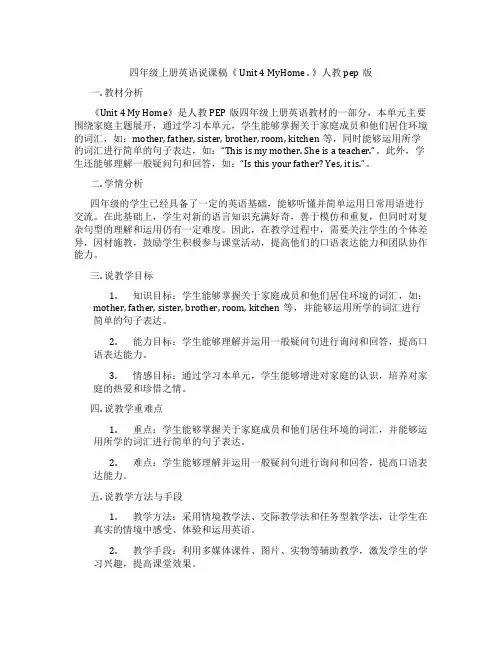
四年级上册英语说课稿《 Unit 4 MyHome . 》人教pep版一. 教材分析《Unit 4 My Home》是人教PEP版四年级上册英语教材的一部分,本单元主要围绕家庭主题展开,通过学习本单元,学生能够掌握关于家庭成员和他们居住环境的词汇,如:mother, father, sister, brother, room, kitchen等,同时能够运用所学的词汇进行简单的句子表达,如:“This is my mother. She is a teacher.”。
此外,学生还能够理解一般疑问句和回答,如:“Is this your father? Yes, it is.”。
二. 学情分析四年级的学生已经具备了一定的英语基础,能够听懂并简单运用日常用语进行交流。
在此基础上,学生对新的语言知识充满好奇,善于模仿和重复,但同时对复杂句型的理解和运用仍有一定难度。
因此,在教学过程中,需要关注学生的个体差异,因材施教,鼓励学生积极参与课堂活动,提高他们的口语表达能力和团队协作能力。
三. 说教学目标1.知识目标:学生能够掌握关于家庭成员和他们居住环境的词汇,如:mother, father, sister, brother, room, kitchen等,并能够运用所学的词汇进行简单的句子表达。
2.能力目标:学生能够理解并运用一般疑问句进行询问和回答,提高口语表达能力。
3.情感目标:通过学习本单元,学生能够增进对家庭的认识,培养对家庭的热爱和珍惜之情。
四. 说教学重难点1.重点:学生能够掌握关于家庭成员和他们居住环境的词汇,并能够运用所学的词汇进行简单的句子表达。
2.难点:学生能够理解并运用一般疑问句进行询问和回答,提高口语表达能力。
五. 说教学方法与手段1.教学方法:采用情境教学法、交际教学法和任务型教学法,让学生在真实的情境中感受、体验和运用英语。
2.教学手段:利用多媒体课件、图片、实物等辅助教学,激发学生的学习兴趣,提高课堂效果。
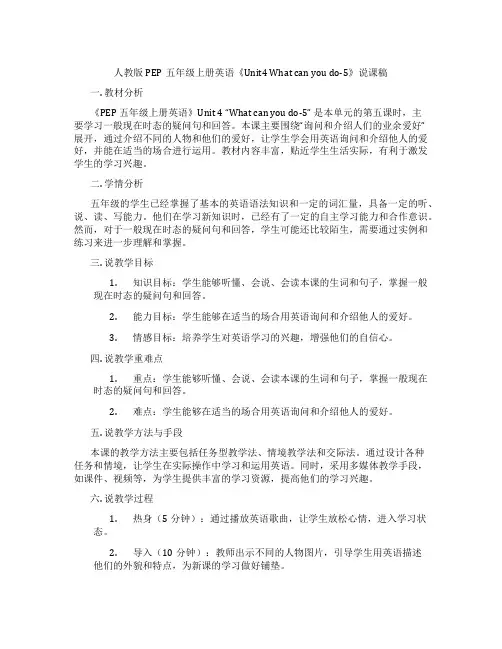
人教版PEP五年级上册英语《Unit4 What can you do-5》说课稿一. 教材分析《PEP 五年级上册英语》Unit 4 “What can you do-5” 是本单元的第五课时,主要学习一般现在时态的疑问句和回答。
本课主要围绕“询问和介绍人们的业余爱好”展开,通过介绍不同的人物和他们的爱好,让学生学会用英语询问和介绍他人的爱好,并能在适当的场合进行运用。
教材内容丰富,贴近学生生活实际,有利于激发学生的学习兴趣。
二. 学情分析五年级的学生已经掌握了基本的英语语法知识和一定的词汇量,具备一定的听、说、读、写能力。
他们在学习新知识时,已经有了一定的自主学习能力和合作意识。
然而,对于一般现在时态的疑问句和回答,学生可能还比较陌生,需要通过实例和练习来进一步理解和掌握。
三. 说教学目标1.知识目标:学生能够听懂、会说、会读本课的生词和句子,掌握一般现在时态的疑问句和回答。
2.能力目标:学生能够在适当的场合用英语询问和介绍他人的爱好。
3.情感目标:培养学生对英语学习的兴趣,增强他们的自信心。
四. 说教学重难点1.重点:学生能够听懂、会说、会读本课的生词和句子,掌握一般现在时态的疑问句和回答。
2.难点:学生能够在适当的场合用英语询问和介绍他人的爱好。
五. 说教学方法与手段本课的教学方法主要包括任务型教学法、情境教学法和交际法。
通过设计各种任务和情境,让学生在实际操作中学习和运用英语。
同时,采用多媒体教学手段,如课件、视频等,为学生提供丰富的学习资源,提高他们的学习兴趣。
六. 说教学过程1.热身(5分钟):通过播放英语歌曲,让学生放松心情,进入学习状态。
2.导入(10分钟):教师出示不同的人物图片,引导学生用英语描述他们的外貌和特点,为新课的学习做好铺垫。
3.呈现(15分钟):教师通过课件展示本课的主要内容,引导学生学习一般现在时态的疑问句和回答。
4.操练(15分钟):学生分组进行角色扮演,用英语询问和介绍他人的爱好。
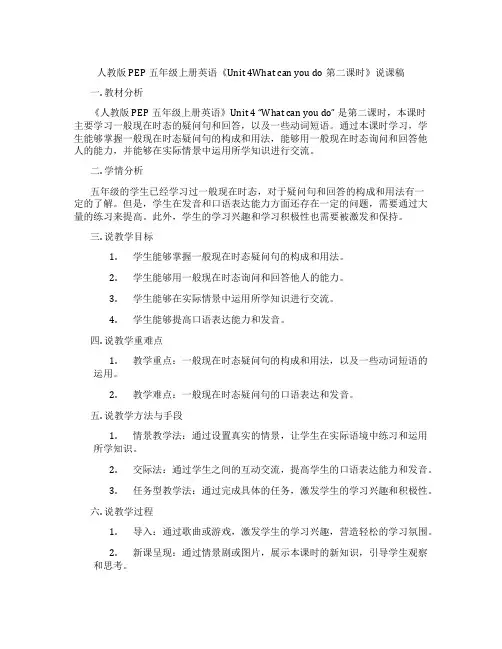
人教版PEP五年级上册英语《Unit 4What can you do第二课时》说课稿一. 教材分析《人教版PEP五年级上册英语》Unit 4 “What can you do” 是第二课时,本课时主要学习一般现在时态的疑问句和回答,以及一些动词短语。
通过本课时学习,学生能够掌握一般现在时态疑问句的构成和用法,能够用一般现在时态询问和回答他人的能力,并能够在实际情景中运用所学知识进行交流。
二. 学情分析五年级的学生已经学习过一般现在时态,对于疑问句和回答的构成和用法有一定的了解。
但是,学生在发音和口语表达能力方面还存在一定的问题,需要通过大量的练习来提高。
此外,学生的学习兴趣和学习积极性也需要被激发和保持。
三. 说教学目标1.学生能够掌握一般现在时态疑问句的构成和用法。
2.学生能够用一般现在时态询问和回答他人的能力。
3.学生能够在实际情景中运用所学知识进行交流。
4.学生能够提高口语表达能力和发音。
四. 说教学重难点1.教学重点:一般现在时态疑问句的构成和用法,以及一些动词短语的运用。
2.教学难点:一般现在时态疑问句的口语表达和发音。
五. 说教学方法与手段1.情景教学法:通过设置真实的情景,让学生在实际语境中练习和运用所学知识。
2.交际法:通过学生之间的互动交流,提高学生的口语表达能力和发音。
3.任务型教学法:通过完成具体的任务,激发学生的学习兴趣和积极性。
六. 说教学过程1.导入:通过歌曲或游戏,激发学生的学习兴趣,营造轻松的学习氛围。
2.新课呈现:通过情景剧或图片,展示本课时的新知识,引导学生观察和思考。
3.新课讲解:通过PPT或板书,讲解一般现在时态疑问句的构成和用法,以及一些动词短语的含义和用法。
4.课堂练习:通过小组活动或个人任务,让学生在实际情景中练习和运用所学知识。
5.巩固练习:通过游戏或竞赛,巩固所学知识,提高学生的口语表达能力和发音。
6.总结:对本课时所学知识进行总结,强调重点和难点。
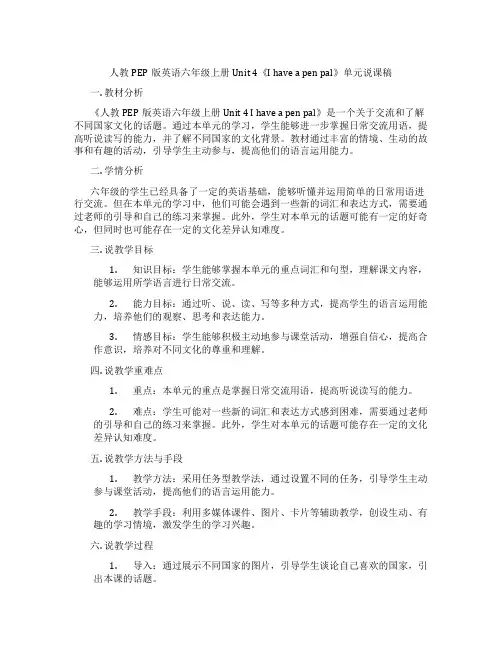
人教PEP版英语六年级上册Unit 4《I have a pen pal》单元说课稿一. 教材分析《人教PEP版英语六年级上册Unit 4 I have a pen pal》是一个关于交流和了解不同国家文化的话题。
通过本单元的学习,学生能够进一步掌握日常交流用语,提高听说读写的能力,并了解不同国家的文化背景。
教材通过丰富的情境、生动的故事和有趣的活动,引导学生主动参与,提高他们的语言运用能力。
二. 学情分析六年级的学生已经具备了一定的英语基础,能够听懂并运用简单的日常用语进行交流。
但在本单元的学习中,他们可能会遇到一些新的词汇和表达方式,需要通过老师的引导和自己的练习来掌握。
此外,学生对本单元的话题可能有一定的好奇心,但同时也可能存在一定的文化差异认知难度。
三. 说教学目标1.知识目标:学生能够掌握本单元的重点词汇和句型,理解课文内容,能够运用所学语言进行日常交流。
2.能力目标:通过听、说、读、写等多种方式,提高学生的语言运用能力,培养他们的观察、思考和表达能力。
3.情感目标:学生能够积极主动地参与课堂活动,增强自信心,提高合作意识,培养对不同文化的尊重和理解。
四. 说教学重难点1.重点:本单元的重点是掌握日常交流用语,提高听说读写的能力。
2.难点:学生可能对一些新的词汇和表达方式感到困难,需要通过老师的引导和自己的练习来掌握。
此外,学生对本单元的话题可能存在一定的文化差异认知难度。
五. 说教学方法与手段1.教学方法:采用任务型教学法,通过设置不同的任务,引导学生主动参与课堂活动,提高他们的语言运用能力。
2.教学手段:利用多媒体课件、图片、卡片等辅助教学,创设生动、有趣的学习情境,激发学生的学习兴趣。
六. 说教学过程1.导入:通过展示不同国家的图片,引导学生谈论自己喜欢的国家,引出本课的话题。
2.新课呈现:通过播放课文动画,让学生整体感知课文内容,然后老师逐句教读,学生跟读。
3.单词和句型学习:学生通过小组活动,用卡片进行单词和句型的练习,老师进行指导和反馈。
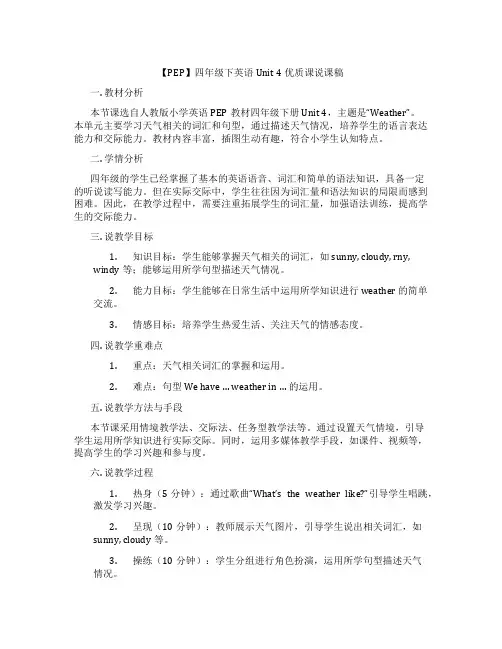
【PEP】四年级下英语Unit 4优质课说课稿一. 教材分析本节课选自人教版小学英语PEP教材四年级下册Unit 4,主题是“Weather”。
本单元主要学习天气相关的词汇和句型,通过描述天气情况,培养学生的语言表达能力和交际能力。
教材内容丰富,插图生动有趣,符合小学生认知特点。
二. 学情分析四年级的学生已经掌握了基本的英语语音、词汇和简单的语法知识,具备一定的听说读写能力。
但在实际交际中,学生往往因为词汇量和语法知识的局限而感到困难。
因此,在教学过程中,需要注重拓展学生的词汇量,加强语法训练,提高学生的交际能力。
三. 说教学目标1.知识目标:学生能够掌握天气相关的词汇,如sunny, cloudy, rny,windy等;能够运用所学句型描述天气情况。
2.能力目标:学生能够在日常生活中运用所学知识进行 weather 的简单交流。
3.情感目标:培养学生热爱生活、关注天气的情感态度。
四. 说教学重难点1.重点:天气相关词汇的掌握和运用。
2.难点:句型We have … weather in … 的运用。
五. 说教学方法与手段本节课采用情境教学法、交际法、任务型教学法等。
通过设置天气情境,引导学生运用所学知识进行实际交际。
同时,运用多媒体教学手段,如课件、视频等,提高学生的学习兴趣和参与度。
六. 说教学过程1.热身(5分钟):通过歌曲“What’s the weather like?”引导学生唱跳,激发学习兴趣。
2.呈现(10分钟):教师展示天气图片,引导学生说出相关词汇,如sunny, cloudy等。
3.操练(10分钟):学生分组进行角色扮演,运用所学句型描述天气情况。
4.拓展(10分钟):学生观看天气预报视频,学会用英语描述天气变化。
5.总结(5分钟):教师带领学生回顾本节课所学内容,加深记忆。
七. 说板书设计板书设计采用思维导图形式,将天气词汇和句型呈现出来,便于学生理解和记忆。
八. 说教学评价本节课采用形成性评价和终结性评价相结合的方式。
人教版新目标七年级英语下册 Unit 4 说课稿一. 教材分析人教版新目标七年级英语下册Unit 4主要围绕“日常生活”这一主题展开,通过学习本单元,学生能够掌握日常生活中的一些常用表达方式,提高他们的口语交际能力。
本单元的主要内容包括:动词短语的运用、现在进行时态的运用、日常交际用语等。
二. 学情分析七年级的学生已经掌握了基本的英语语法和词汇,但对日常生活中的一些交际用语还不太熟悉。
因此,在教学过程中,教师需要注重引导学生运用所学知识进行实际交流,提高他们的口语表达能力。
三. 说教学目标1.知识目标:学生能够掌握本单元的生词和短语,理解日常交际用语的含义和用法。
2.能力目标:学生能够熟练运用现在进行时态进行日常交际,提高他们的口语表达能力。
3.情感目标:激发学生学习英语的兴趣,培养他们积极参与课堂活动的自信心。
四. 说教学重难点1.重点:学生能够掌握现在进行时态的运用,以及日常交际用语的表达。
2.难点:学生能够灵活运用现在进行时态进行日常交际,并在实际情境中正确使用。
五. 说教学方法与手段1.教学方法:采用任务型教学法,情境教学法,分组合作学习等。
2.教学手段:利用多媒体课件、图片、卡片等辅助教学,激发学生的学习兴趣。
六. 说教学过程1.导入:通过展示图片,引导学生谈论图片中的人物正在做什么,引入现在进行时态的学习。
2.新课呈现:教师通过情境教学,展示日常交际用语,引导学生学习并掌握相关短语和表达。
3.课堂练习:学生分组进行角色扮演,运用所学知识进行实际交流,教师给予指导和反馈。
4.巩固环节:学生进行听力练习,观看相关情景对话,理解并运用日常交际用语。
5.拓展环节:学生进行小组讨论,创造性地运用所学知识,创作自己的日常交际对话。
6.总结:教师对本节课的主要内容进行总结,强调现在进行时态的运用和日常交际用语的重要性。
七. 说板书设计板书设计要简洁明了,突出重点。
主要包括现在进行时态的构成、日常交际用语的表达等。
PEP英语五年级下册第四单元《Unit 4 When is the art show》说课稿含反思一. 教材分析PEP英语五年级下册第四单元《Unit 4 When is the art show》主要围绕“时间”这一主题展开,通过介绍不同活动的具体时间,帮助学生掌握一般现在时态和一般将来时态的用法。
本节课的主要内容包括:1. 学习表示时间的词汇,如:tomorrow, next week, next month等;2. 学习如何询问和回答关于时间的问题;3.通过听力、口语、阅读和写作等多种方式,实践和巩固所学知识。
二. 学情分析五年级的学生已经掌握了基本的英语语法和词汇,对一般现在时态和一般将来时态有一定的了解。
但在实际运用中,部分学生可能会对时态的运用产生混淆。
此外,学生的英语听说能力参差不齐,需要在教学过程中给予不同程度的学生个别关注。
三. 说教学目标1.知识目标:学生能够掌握表示时间的词汇,如:tomorrow, nextweek, next month等;能够用英语询问和回答关于时间的问题。
2.能力目标:学生能够听懂、会说、会读、会写关于时间的相关句子,并在实际情景中运用所学知识。
3.情感目标:激发学生学习英语的兴趣,培养学生的团队协作能力和自主学习能力。
四. 说教学重难点1.重点:学生能够掌握表示时间的词汇和句型,能够在实际情景中运用一般现在时态和一般将来时态。
2.难点:学生能够正确运用一般现在时态和一般将来时态,询问和回答关于时间的问题。
五. 说教学方法与手段1.采用任务型教学法,让学生在完成实际任务的过程中,锻炼语言运用能力。
2.运用多媒体教学手段,如:PPT、视频等,为学生提供丰富的视觉和听觉材料。
3.分组合作学习,激发学生的团队协作精神,提高学生的口语表达能力。
六. 说教学过程1.热身(5分钟):通过唱一首关于时间的英文歌曲,激发学生的学习兴趣,复习已学的表示时间的词汇。
2.呈现(10分钟):教师展示一幅美术馆的宣传海报,引导学生关注海报上的时间信息,引出本节课的主题。
【人教版】新目标八年级英语上册:Unit 4 单元说课稿一. 教材分析新目标八年级英语上册Unit 4主要围绕着“过去进行时”的语法知识点展开。
这一单元的话题是关于过去发生的事情,通过学习让学生能够运用过去进行时描述过去正在进行的动作。
教材通过丰富的生活情境,引导学生理解和运用过去进行时,提高他们的语言运用能力。
二. 学情分析学生在学习这一单元之前,已经掌握了基本的英语语法知识,对动词时态有了初步的了解。
但他们在运用过去进行时方面可能会遇到困难,因此需要通过实例和练习来加强理解和运用。
此外,学生需要提高听、说、读、写四项基本技能,特别是在口语表达和写作方面。
三. 说教学目标1.知识目标:让学生掌握过去进行时的构成、意义和用法,能够正确运用过去进行时描述过去正在进行的动作。
2.能力目标:提高学生的听、说、读、写能力,使他们能够在实际情境中运用过去进行时。
3.情感目标:激发学生学习英语的兴趣,培养他们积极向上的学习态度。
四. 说教学重难点1.重点:过去进行时的构成、意义和用法。
2.难点:如何运用过去进行时描述过去正在进行的动作,以及如何在实际情境中正确使用。
五. 说教学方法与手段1.采用任务型教学法,让学生在完成任务的过程中,自然地学习和运用过去进行时。
2.运用多媒体教学手段,如课件、视频等,为学生提供丰富的学习资源,提高他们的学习兴趣。
3.小组讨论和课堂展示,激发学生的合作意识和竞争意识。
六. 说教学过程1.导入:通过提问学生昨天做了什么,引导学生思考过去正在进行的动作,激发他们对过去进行时的兴趣。
2.呈现:通过课件展示过去进行时的结构,让学生初步了解过去进行时的概念。
3.讲解:详细讲解过去进行时的构成、意义和用法,并通过实例进行说明。
4.练习:设计不同类型的练习题,让学生在实际操作中掌握过去进行时的运用。
5.运用:学生进行小组讨论,让他们运用过去进行时描述过去发生的事情。
6.总结:对本节课的内容进行总结,强调过去进行时的关键点。
初中英语九年级 Unit 4 第1课时 (Section A 1a-2d)(说课稿)一. 教材分析《初中英语九年级 Unit 4 第1课时 (Section A 1a-2d)》是人教版初中英语教材九年级上册的一篇文章。
本节课主要讲述了一对夫妇在业余时间如何安排他们的生活。
通过本节课的学习,学生可以掌握一般现在时态的用法,学会描述日常生活中的活动和安排。
教材内容贴近学生的生活,有利于激发学生的学习兴趣和积极性。
二. 学情分析九年级的学生已经掌握了英语学习的基本语法和词汇,具备一定的听、说、读、写能力。
但部分学生对一般现在时态的用法还不够熟练,需要在课堂上进行针对性的训练。
此外,学生的学习动机、学习习惯和学习方法等方面存在差异,教师需要关注每个学生的个体差异,因材施教。
三. 说教学目标1.知识目标:学生能够掌握一般现在时态的构成和用法,正确运用一般现在时态描述自己和别人的日常生活。
2.能力目标:学生能够听懂、会说、会读、会写本节课的重点单词和句型,提高英语表达能力。
3.情感目标:学生能够培养良好的学习习惯,积极参与课堂活动,增强自信心。
四. 说教学重难点1.教学重点:一般现在时态的构成和用法,以及如何运用一般现在时态描述日常生活。
2.教学难点:一般现在时态的用法,尤其是如何正确运用一般现在时态描述生活习惯和安排。
五. 说教学方法与手段1.教学方法:采用任务型教学法、情境教学法和交际法,引导学生通过完成任务、参与情境和互动交流来学习英语。
2.教学手段:利用多媒体课件、图片、卡片等辅助教学,激发学生的学习兴趣和积极性。
六. 说教学过程1.导入:通过提问学生日常生活中的活动和安排,引出本节课的主题。
2.新课呈现:展示教材中的1a-2d部分,让学生听懂对话内容,并回答相关问题。
3.语法讲解:讲解一般现在时态的构成和用法,让学生对比过去时态,加深对一般现在时态的理解。
4.实践环节:学生分组进行角色扮演,运用一般现在时态描述自己和别人的日常生活。
人教PEP版英语五年级上册Unit 4《What can you do》说课稿一. 教材分析人教PEP版英语五年级上册Unit 4《What can you do》是一篇以日常活动为主题的教学内容。
本节课的主要目的是让学生掌握情态动词can的用法,能够询问和描述别人以及自己会做什么。
通过本节课的学习,学生能够进一步培养英语听、说、读、写的能力,提高他们的语言运用能力。
二. 学情分析在五年级的学生中,他们已经有了一定的英语基础,能够听懂并运用一些基本的英语单词和句型进行交流。
但是,对于情态动词can的用法,他们可能还比较陌生,需要通过本节课的学习来掌握。
同时,学生在学习过程中可能存在个体差异,有的学生可能表达能力较强,而有的学生可能在听力方面有待提高。
三. 说教学目标1.知识目标:学生能够掌握情态动词can的用法,能够用英语询问和描述别人以及自己会做什么。
2.能力目标:通过本节课的学习,学生的听、说、读、写能力得到进一步提高。
3.情感目标:学生能够积极参与课堂活动,增强自信心,提高学习英语的兴趣。
四. 说教学重难点1.重点:学生能够掌握情态动词can的用法,能够用英语询问和描述别人以及自己会做什么。
2.难点:学生能够正确运用情态动词can进行问答,并在实际情境中灵活运用。
五. 说教学方法与手段在本节课的教学过程中,我将采用任务型教学法,通过创设情境,引导学生参与各种课堂活动,提高他们的听、说、读、写能力。
同时,我会利用多媒体教学手段,如图片、视频等,帮助学生更好地理解和运用所学知识。
六. 说教学过程1.热身(5分钟):通过播放一首与日常活动相关的英语歌曲,让学生放松身心,同时激发他们对本节课的兴趣。
2.引入(10分钟):通过展示一张日程表,引导学生思考并说出自己的一天,为新课的学习做好铺垫。
3.呈现(15分钟):通过展示教材中的插图,引导学生观察并说出图中人物会做什么。
然后,教师呈现情态动词can的用法,并进行讲解和示范。
Unit4 How do you get to school?1a—1c王臻Good morning, everyone. I’m Wang Zhen. I come from Wugou Middle School. Today I will talk about SectionA,1a—1c of Unit4 How do you get to school? Book A,Grade 8. I want to say it from four parts.Part1:Analysis of the teaching materials.1.Status and function.This lesson is important, the students will learn the ways of transportation. Such a topic is related to their daily life. So it can raise the students’ learning interest and improve their spoken English.2. Analysis of the students.Students of Grade 8 have learned English for about three years. They have mastered some skills of listening, speaking, reading and writing . They have taken a good interest in English now and they enjoy learning English.3.Teaching aims and demands.a.Knowledge aims:1.To learn the new words“take, subway, train. ”2.To make the students know how to use the sentences“How do you get to school?How does he/she get to school?”and how to answer these questions.b.Ability aims:1.To use the target language to talk about the ways of transportation.2.To develop the students’ ability of communication by learning the useful structures.c.Modal aim:1.To enable the students to work with others and help each other.2.To remind the students to have a good safety consciousness and protect our environment.Teaching key points:1.To make the students use the new words and expressions properly.2.How-special question.Teaching difficulties: the first to the third change of the present tense.Part2:Analysis of the teaching methods.Teaching methods: task—based teaching method, audio—visual teaching method and communicative teaching method.To use these methods is helpful to develop the students’ thought. As we all know, the main aims of learning English in Middle School is to cultivate the students’ abilities of listening, speaking, reading and writing. So I use these methods. That is to say, I will let the students get the better understanding of the key structures. I’ll also give the students some tasks and arrange five kinds of activities: guessing games, watching CAI, listening practice, acting out dialogues and making a survey.Learning methods: According to the teaching methods, I request the students to study English independently and cooperatively. The students who sit at the same table and groups can make a discussion and learn from each other. It makes the students more relaxed. It can arouse the students to think and to say what they want to say. The students become more relaxed and pleased in this kind of situation.In this lesson, I plan to use the multi-media computer and some cards. These teaching aids can arouse the students’ interest and help me finish the teaching tasks.Part 3: Analysis of teaching procedures.Step I. Leading in1. Broadcast some sounds of different ways of transportation. Conduct the students to guess the names of the transportation. Review the words “bus, car, taxi and bike”.2.Tell the students this lesson we will learn the ways of transportations, then lead in the title of this unit “How do you get toschool?” Write it down on the blackboard.Guessing the ways of transportation by listening to the sounds of them will attract the students’ attention and improve their interest. Step II. Presentation1.Show some pictures, learn the new words and expressions, then ask students “How do you get to school?” Help the students answer “take the bus, take the subway, take the train, ride a bike, walk”.2.Play a memory game. Just show the pictures of the transportation on the screen as quickly as possible, let the students say them out quickly in English. The fastest student will be the winner, I’ll give him/her some cards as a prize.This step should use the multi-computer to make a good effect. 3.Ask the students to work in pairs to practice the conversation like this:A: How do you get to school? B: I take the bus to school.4.Play a guessing game. How does he/she get to work? I’ll ask the students about some focus stars . T:How does Yao Ming get to work? Ss:He/She rides the bike/…to work every day. The pop stars are popular among the students in China, the students must be interested in them.5. Ask the students to complete 1a, then check the answers with them.To present the ways of transportation by CAI is more easier for the students to learn and grasp the meanings. CAI can provide a real situation with its pictures. I’ll Encourage them to use different words and find out the best group. “Task-based” teaching method is used here to develop the students’ ability of communication and cooperation.Step III. Listening practice1.Before playing 1b, ask the students: How do you get to school? Let the students remember the ways of transportation.2.Play the tape at first, let the students just listen, play it again, askthem to complete 1b , then check the answers. At last, ask them to listen and imitate the conversations for another time.Although the listening practice is easy for the students to finish, having a good listening habit is good for their listening ablity.3. Watch a short movie and choose the right order they hear the transportations. This step can make the students both consolidate the target language and arouse their learning interest.4. Ask two students to read the conversation, then let the students practice in pairs. After that, ask them to practice in groups like this: A: How do you get to school? B: I take a subway.C: How does B get to school? D: He takes a subway.In this step, the students are required to practice the sentence patterns in pairs by reading the dialogue aloud and they’ll grasp the patterns. At last I’ll ask the students to think hard and act it out well. I’ll give them some cards with numbers as a prize.Step IV. Consolidation1. Tell the students another way of these sentences on the screen and practice: take the/a transportation to somewhere and get/go to somewhere by transportation have the same meaning. But before here, there and home, we can’t use “to”.This step is used to train the students’ ability of using English in many ways.1. Show a chart on the screen. Devide the students in groups of four. Let the students make conversations like this:A: How do get to school? B: I ….2. Conduct the students make a report like this: Bob takes the busto school. Larry rides her bike to school. Yang Lan goes to school by subway and I walk to school.I think survey is so important that the students should speak as much as they can. It is necessary for the students to investigate others to consolidate the knowledge they learned.StepVI.General trainingⅠ.Phrases乘公共汽车步行____________________乘飞机乘地铁________________________骑车乘火车________________________Ⅱ.Fill in the blanks with the words give already.ride take get to by1)How do you ________ school in the morning?2)When it rains, I _______ a taxi.3)I like to ______ my bike on the weekend.4)Mary’s mother gets to work car.5)My math teacher the bus to work. StepVII. HomeworkLet the students make a survey –How do your family members get to school or get to work ? How do your teachers get to work? Then write a report.Part4:Analysis of the blackboard design.Unit4 How do you get to school?take the bus/train/subway A: How do you get to school? ride a bike B: I ride my bike.walk A: How does he get to school?B: He walks to school.In my opinion, the blackboard design can reflect the teacher’s ability of mastering the key and difficult points. It can also make the students master the importance easily. So I adopt the inductive and instructive blackboard design.感谢您的阅读,祝您生活愉快。